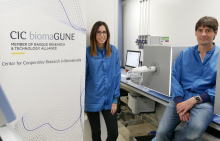
Nanorobots are machines whose components are on the scale of nanometers (one millionth of a millimeter), and which can be designed in such a way that they can move autonomously in certain environments, be they artificial or natural. Although they are still in the research and development phase, hugely significant progress is being made to turn nanorobots into reality in medical practice. They have a whole host of applications: ranging from the identification and location of tumor cells, the release of drugs in specific parts of the body, to tissue engineering and cellular assistance in inflammatory responses. Among the various, most promising nanorobot systems are those that are self-propelled by catalytic enzymes. However, understanding the collective behavior of these nanorobots is crucial when it comes to progressing towards clinical practice.
In a new study published in the journal Science Robotics, the Radiochemistry and Nuclear Imaging research group at CIC biomaGUNE led by Jordi Llop, together with the Smart Nano Bio Devices group at the Institute for Bioengineering of Catalonia (IBEC) led by ICREA research professor Samuel Sánchez, the Autonomous University of Barcelona (UAB) and the Università degli studi di Roma Tor Vergata, have been able to observe in vivo the collective behavior of a large number of nanorobots designed at the IBEC to move autonomously inside the body through radioactive isotope labelling. "The fact that we have been able to see how the nanorobots move together, as in a swarm, and to follow them inside a living organism, is highly significant, since millions of them are needed to treat specific disorders, such as tumor alterations," said Samuel Sánchez, principal researcher at IBEC. "We have demonstrated, for the first time, that nanorobots can be monitored in vivo using positron emission tomography (PET), a highly sensitive, non-invasive technique currently used in the clinical setting," explained Jordi Llop, principal researcher at CIC biomaGUNE's radiochemistry and nuclear imaging laboratory.
To this end, the researchers first conducted in vitro experiments by monitoring the nanorobots through optical microscopy and positron emission tomography (PET). Both techniques made it possible to observe how the nanorobots blended with the fluids and were able to migrate, collectively, following complex paths. The nanorobots were then administered intravenously to mice and finally inserted via intravesical means into the bladders of these animals. The nanorobots had a built-in enzyme –urease– capable of using urea in the urine as fuel, which is why they were able to move easily in this medium.

PET-CT imaging obtained 0, 25 and 45 minutes after the nanorobots were delivered in the presence of urea (Pedro Ramos, Cristina Simó / CIC biomaGUNE, IBEC, UAB).
Collective movements resembling flocks of birds or shoals of fish
The team confirmed that the distribution of the nanodevices inside the bladders of the mice was homogeneous, indicating that the collective movement was coordinated and efficient. "The nanorobots perform collective movements similar to those found in nature, such as those of birds flying in flocks, or the orderly patterns followed by shoals of fish," explained the IBEC lead researcher Samuel Sánchez. "We have seen that nanorobots that have urea on the surface move much faster than those that do not. This is therefore a proof of concept of the initial theory that nanorobots will be able to reach a tumor better and penetrate further into it," said Jordi Llop, lead researcher at CIC biomaGUNE.
This study demonstrates the high efficiency of millions of nanoscopic devices enabling them to move in a coordinated manner in both in vitro and in vivo environments, which is a major breakthrough in the race to turn nanorobots into key players in high-precision therapies and treatments. It has also been demonstrated "that the movement of these devices can be monitored using imaging techniques that can be applied to the in vivo environment, in other words, they can be applied in test animals and offer the potential for transfer to humans," added Cristina Simó, one of the first authors of the study and a researcher in the CIC biomaGUNE group.
Future applications in medicine of these nanometric-scale devices are promising. “Swarms of nanorobots” could be particularly useful in viscous environments, where drug diffusion is often limited by poor vascularization, such as in the gastrointestinal tract, the eye, or joints. "In fact, since different enzymes can be incorporated into the motors, nanorobots could be tailor-made depending on the target within the body by adapting the device to the fuel that can be accessed in the environment where they need to move," concluded Samuel Sánchez.
Swarming behavior and in vivo monitoring of enzymatic nanomotors within the bladder
Hortelao, AC; Simó, C; Guix, M; Guallar-Garrido, S; Julián, E; Vilela, D; Rejc, L; Ramos-Cabrer, P; Cossío, U; Gómez-Vallejo, V; Patiño, T; Llop, J; Sánchez, S.
Sci Robot, 2021, DOI: 10.1126/scirobotics.abd2823
Video The collective movement of the nanorobots delivered in the presence of urea can be seen. Firstly, two phases are generated, but this effect ends up being cancelled, and a homogeneous distribution across the bladder is obtained (Pedro Ramos, Cristina Simó / CIC biomaGUNE, IBEC, UAB).
Nota de Prensa
Prentsa Oharra
